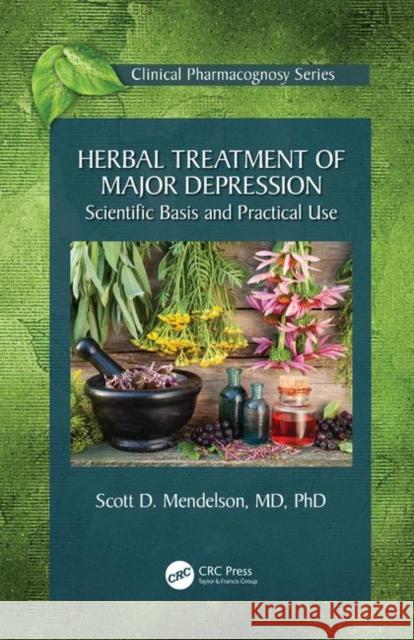Herbal Treatment of Major Depression: Scientific Basis and Practical Use » książka



Herbal Treatment of Major Depression: Scientific Basis and Practical Use
ISBN-13: 9780367375324 / Angielski / Twarda / 2019 / 420 str.
Herbal Treatment of Major Depression: Scientific Basis and Practical Use
ISBN-13: 9780367375324 / Angielski / Twarda / 2019 / 420 str.
(netto: 834,48 VAT: 5%)
Najniższa cena z 30 dni: 869,02
ok. 22 dni roboczych
Bez gwarancji dostawy przed świętami
Darmowa dostawa!
This unique volume presents new understandings of the neurochemical nature of major depression, and how herbs and their constituent flavonoids and terpenes appear to address some of the mechanisms now thought to be involved.
Table of Contents 1 Major Depressive Disorder: A brief history of Western medical treatment 2 How antidepressants work, but often do not 3 Clues revealed by ketamine 4 New understanding of the nature and causes of Major Depressive Disorder 4.1 Oxidative and nitrosative damage 4.2 Inflammation 4.3 Chronic Stress 4.4 Insulin resistance 4.5 Metabolic Syndrome 4.6 Summary 5 Phytochemicals: Some basics 5.1 Carbohydrates 5.2 Lipids 5.3 Terpenes 5.4 Phenolics 5.41 Flavonoids 5.42 Non-flavonoid phenolics 5.5 Alkaloids 5.6 Summary 6 Models and paradigms for assessment of antidepressant effects 6.1 Antioxidant Effects 6.2 Anti-inflammatory Effects 6.3 Antidiabetic/Anti-Metabolic Syndrome Effects 6.4 Preclinical antidepressant-like effects 6.4.1 Forced Swim Test 6.4.2 Tail suspension Test 6.4.3 Sucrose Consumption Test 6.4.4 Test Conditions 7 Herbs with antidepressant effects 7.1 Allium sativum (Garlic) 7.2 Angelica sinensis 7.3 Apium graveolens (celery) 7.4 Astragalus membranaceus 7.5 Atractylodes macrocephala 7.6 Avena sativa (common oat) 7.7 Bacopa monnieri 7.8 Borage officinalis (European Borage) 7.9 Bupleurum chinense 7.10 Camellia sinensis (Tea) 7.11 Cannabis 7.12 Cecropia 7.13 Centella asiatica (Gotu Kola) 7.14 Chrysactinia Mexicana 7.15 Cimicifuga racemosa (Black cohosh) 7.16 Cinnamomum zeylanicum (Cinnamon) 7.17 Coffea arabica (Coffee) 7.18 Coriandrum sativum (Coriander) 7.19 Corydalis yanhusuo 7.20 Crocus sativa (Saffron) 7.21 Curcuma longa (Turmeric) 7.22 Cyperus rotundus 7.23 Echium amoenum 7.24 Eleutherococcus senticoccus (Siberian Ginseng) 7.25 Epimedium brevicornum (Horny goat weed) 7.26 Foeniculum vulgare (Fennel) 7.27 Ginkgo biloba 7.28 Glycyrrhiza (licorice) 7.29 Hedyosmum Brasiliense 7.30 Hemerocallis citrina (Daylily) 7.31 Hericium erinaceus (Lion’s Mane) 7.32 Hibiscus rosa-sinensis (Hibiscus) 7.33 Humulus lupulus (Hops) 7.34 Huperzia serrata 7.35 Hypericum perforatum (St. John’s wort) 7.36 Ilex paraguariensis (Yerba mate) 7.37 Lavandula (Lavender) 7.38 Ligusticum chuanxiong 7.39 Magnolia officinalis 7.40 Matricaria recutita (Chamomile) 7.41 Melissa officinalis (Lemon balm) 7.42 Mimosa pudica 7.43 Ocimum basilicum (Sweet Basil) 7.44 Origanum vulgare (Oregano) 7.46 Panax ginseng (Ginseng)45 Paeonia lactiflora (Peony) 7.47 Passifloraceae incarnata (Passionflower) 7.48 Piper methysticum (Kava) 7.49 Piper nigrum (Black Pepper) 7.50 Polygala tenuifolia 7.51 Poria cocos 7.52 Psoralea corylifolia 7.53 Rhodiola rosea 7.54 Rosmarinus officinalis (Rosemary) 7.55 Salvia divinorum 7.56 Sceletium tortuosum 7.57 Schisandra chinensis 7.58 Scutellaria lateriflora (Skullcap) 7.59 Silybum marianum (Milk Thistle) 7.60 Theobroma cacao (Chocolate) 7.61 Tilia (Linden) 7.62 Trigonella foenum-graecum (Fenugreek) 7.63 Valeriana officinalis (Valerian) 7.64 Verbena officinalis (Vervain) 7.65 Vitex agnus-castus (Chaste tree) 7.66 Withania somnifera (Ashwagandha) 8 The antidepressant effects of Yueue, and the herbs of Traditional Chinese Medicine 8.1 Fundamental considerations 8.2 Yueju 8.3 Xiao yao san 8.4 Chai hu shu gan 8.5 Gan mai da zao 8.6 Gui pi 8.7 Shi wei wen dan tang 8.8 Ban xia hou pu 8.9 Chai hu jia long gu mu li 8.10 Tiao qi 8.11 Yi pi 8.12 Tang shen kang 8.13 Kai xin san 8.14 Shu gan jie yu 8.15 Si ni san 8.16 Wu ling 8.17 Other TCM herbs used in the treatment of MDD 8.18 A medical, "Theory of Everything." 9 Flavonoids with preclinical antidepressant-like effects 9.1 Amentoflavone 9.2 Apigenin 9.3 Astilbin 9.4 Baicalein and Baicalin 9.5 Chrysin 9.6 7,8,Dihydroxyflavone 9.7 Fisetin 9.8 Heptomethoxyflavone 9.9 Hesperidin and hesperitin 9.10 Hyperoside 9.11 Icariin 9.12 Isosakurentin-5-O-rutinoside 9.13 Kaempferol 9.14 Liquiritin and Isoliquirtin 9.15 Luteolin 9.16 Miquelianin 9.17 Myricetin 9.18 Naringenin and naringin 9.19 Nobiletin 9.20 Orientin 9.21 Quercetin 9.22 Vitexin 9.23 Wogonin and wogonoside 9.24 Synthetic flavonoids 9.25 Mechanisms of flavonoid antidepressant action 10 Preclinical antidepressant-like effects of terpenes, polyphenolics, and other non-flavonoid phytochemcials 10.1 Amyrins 10.2 Bacopasides 10.3 Berberine 10.4 3-n-Butylphthalide 10.5 Caffeic Acid 10.6 β-Carotene 10.7 Carvacrol 10.8 β-Caryophyllene 10.9 Chlorogenic acid 10.10 Crocin 10.11 Curcumin 10.12 3,6′‐Disinapoyl sucrose 10.13 Ellagic acid 10.14 Eugenol 10.15 Ferulic acid 10.16 Gallic acid 10.17 Gastrodin 10.18 Genipin 10.19 Ginsenoside Rg1 10.20 Glycyrrhizin 10.21 4-Hydroxyisoleucine 10.22 Hyperfoliatin 10.23 Linalool 10.24 Macranthol 10.25 Methyl jasmonate 10.26 Mitragynine 10.27 Oleanolic acid 10.28 Orcinol 10.29 Paeoniflorin 10.30 Paeonol 10.31 Palmatine 10.32 Plumbagin 10.33 Podoandin 10.34 Punarnavine 10.35 Resveratrol 10.36 Riparin 10.37 Rosmarinic acid 10.38 Safranal 10.39 Salidroside 10.40 Sarsasapogenin 10.41 Scopoletin 10.42 Sulphoraphane 10.43 Tetrandrine 10.44 L‐theanine 10.45 Uliginosin B 10.46 Ursolic acid 10.47 Vanillin 11 Choosing herbal treatments 11.1 Efficacy of herbal treatments of MDD 11.2 Herbs for which there is less than compelling evidence of efficacy 11.3 Combinations of Herbs 11.4 Addressing Comorbidities 11.4.1 Anxiety and insomnia 11.4.2 Obsessive-Compulsive Disorder 11.4.3 Premenstrual and perimenopausal symptoms 11.4.4 Dementia 11.4.5 Diabetes and Metabolic Syndrome 11.4.6 Fatigue, lack of resiliency and General Malaise 11.5 Augmentation of standard antidepressant treatment with herbs. 11.6 Safety
Currently a practicing psychiatrist in Roseburg, Oregon, the author earned a Ph.D. in Biopsychology at The University of British Columbia, in Vancouver, British Columbia. He then worked for three years as a post-doctoral fellow at The Rockefeller University in the Laboratory of Neuroendocrinology under Bruce McEwen, Ph.D. During his doctoral work and as a post-doctoral fellow, he published 24 papers on the subjects of serotonergic and hormonal regulation of sexual behavior, and on the effects of stress on serotonin receptor subtypes in the brain. The author then attended medical school at The University of Illinois, and after graduating in 1996, he did his residency in psychiatry at The University of Virginia. In 2007, Elsevier published his first book, Metabolic Syndrome and Psychiatric Illness: Interactions, pathophysiology, assessment and treatment. In 2009, M. Evans published his second book, Beyond Alzheimer’s: How to avoid the modern epidemic of dementia
1997-2025 DolnySlask.com Agencja Internetowa
KrainaKsiazek.PL - Księgarnia Internetowa









